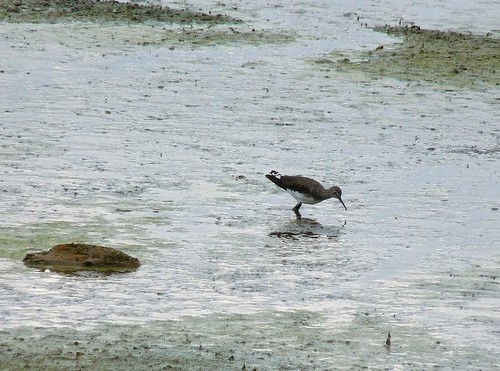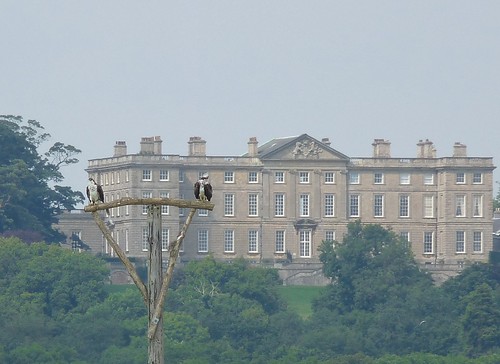This weekend saw me heading on the long journey up North to Leeds to attend a friends wedding on Saturday. When I awoke to glorious sunshine I was a bit annoyed that I was going to be missing the best day to be outdoors that we have had for the last couple of weeks. The day wasn’t to be a total loss though as apart from the wedding itself being a great day, the reception took place in the grounds of Harewood house. As we were being served drinks and nibbles in the ornamental gardens to the front of the property, I noticed an RSPB ‘Aren’t Birds Brilliant’ station set up with a few telescopes trained on the nearby trees. Being curious I wandered over and had the pleasure of watching a female Red Kite sitting on a nest in a tree next to the house. Apparently this individual originated from Northumberland, some 124 miles to the north. It just goes to show how widespread these magnificent birds are now becoming. This particular bird didn’t even seem to mind the music from a rather cheesy DJ. I suppose that it’s probably used to it by now!
We were originally planning on returning straight back to Swansea on the Sunday until I realised that the reserve at Rutland Water was a short detour away. It had been at least seven years since I last visited so I thought that a return visit was long overdue. After paying the very reasonable £4 entrance fee (even better when you consider that the parking is completely free and the pass allows you entry to both reserves that border Rutland Water), we popped up to the upper deck of the Anglian Water Birdwatching Centre where large windows give commanding views over one of the main lagoons. The first birds that I clapped eyes on were a single Spotted Redshank and two Green Sandpipers feeding on the near shore. This was going to be a good day. Further out on the water a good mix of wildfowl in the form of Gadwall, Tufted Duck, Shellduck, Shoveller and Teal was present. Most of these birds were now in eclipse plumage which made identification a tad challenging for a while before I managed to get my eye in. The Gadwall were particularly difficult, looking a lot like female Mallards at this time of the year. Towards the back of the lagoon was what must be one of the largest collections of Cormorants at an inland location in the country. I counted over one hundred individuals before giving up. The sky above the air was no quieter with a good number of Common Terns screeching and fishing. Not to be outdone a nearby colony of Sand Martins numbering over 70 individuals were putting on a good aerial display. It was somewhat surprising that we only saw a couple of Swallows and no Swifts however.
From the visitor centre it is possible to either head north or south to visit some of the twenty seven hides at the reserve. We decided to head North as most of the hides looked over lagoons rather than the main reservoir itself. Many of the pools held very good numbers of wildfowl such as those seen from the centre, but added other species such as Little Egret and a few more Green Sandpipers. My first sighting of this species was only a couple of weeks ago at Upton Warren and now they seem to be everywhere! A particular highlight was a kingfisher who chose to sit on rocks just below the opening in a hide that I was looking out of. It is by far the best view that I have had of a Kingfisher anywhere. By the time that I had got my camera out he had unfortunately realised that he was visible and flew off further around the pool. The woods and bushes on the walks between hides were alive with wildlife, including Whitethroat, Reed Bunting, Blackcap and my very first Stock Dove and the first lifer of the day. Due to their similarity with feral pigeons I have always been dubious in the past of finding an example that I deemed tick worthy, but this individual had every identification marking in place.
Over the last few moths, Anglian Water has been undertaking some major works to create new shallow pools to better control the water levels across the reserve in an age of ever increasing water consumption. The result has been the creation of a huge new lagoon and several hides from which to view it. As we were walking across to the first of these hides a large bird of prey swooped overhead. I knew instantly that we had just had a close encounter with an Osprey. Rutland Water first hatched an Osprey chick in 2001 and since then they have been going from strength to strength. Even so I didn’t expect to get views like that. At the hide we were were able to watch a pair of Ospreys sitting and feeding on top of a large pole that has been erected in the middle of the lagoon. These birds are apparently an immature pair which bodes well for the future breeding success at this site. Out on the water were yet more Common Terns as well as a family of Little Ringed Plovers. After moving on to another hide looking over the same pool we were able to get even better views of the Ospreys, including a charming scene where they both decided to take a bath in the shallow water.
I thought that things couldn’t get much better than that but we were fortunate to find ourselves in a hide with a couple of people who were very eager to share information on what they could see. This was so nice to see as you do find a fair degree of hostility on occasions when asking someone for help when trying to locate a bird that they have been discussing. Anyway, the first thing we picked up on were two Ruff feeding in the shallows, quickly followed by a group of six Egyptian Geese on one of the islands. Nearby were a couple of Golden Plovers in full summer plumage. The highlight though was the Gulls. Amongst the Black Headed and Lesser Black Backed Gulls we picked up several Common Gulls and the second lifer of the day for me in the shape of a Yellow Legged Gull. I would never have been confident in positively identifying one without the knowledge of someone with far more experience, but once pointed out the differences to mark one out from a Herring or Lesser Black backed Gull were clear. In fact I believe that I have seen a few in the past but never realised what I was looking at.
After that last flurry of activity it was time to head home as it was getting late and we still had a good four hour drive ahead of us. We had covered barely half of the reserve but what we had seen had been amazing, especially considering the time of the year. As we get further into Autumn a weekend visit is definitely on the cards as the birds present can only get better as the migrants begin to arrive.







0 Comments